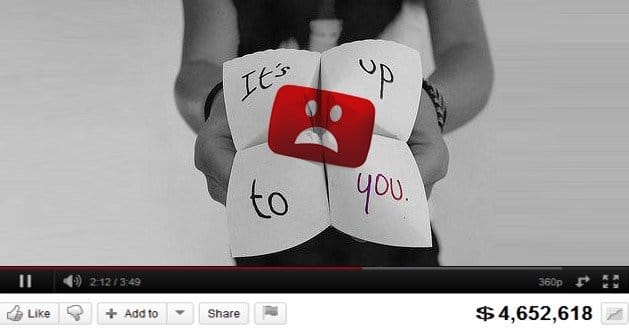 Written by ContentPowered.com
Written by ContentPowered.comWith the web being more and more driven by social media, the principle ideas behind SEO are starting to make their way onto social networks. YouTube, which is easily the world’s most popular website for sharing videos, is one of the sites whose popularity makes publishes salivate. As such, a variety of different tactics for increasing a video’s popularity have become known. One of the most popular of these is purchasing YouTube views. However, many publishers who are new to the concept wonder if it is dangerous.
Not An Uncommon Strategy
To be clear, the strategy of buying YouTube views is somewhat unique, but this sort of pay-for-statistics approach isn’t unique to the video spectrum. Twitter, another of the Internet’s most popular social networks, often sees companies offering services for companies using its platform. These are services that offer pay-for-tweets and pay-for-follower strategies. In essence, it’s no different from buying YouTube views. Page views, another key metric in measuring the web’s traffic, are another sort of pay-for-popularity tactic.
Some YouTube publishers might ask why, though. Just as in the case of Twitter and page-view services, the appeal is in the popularity. Just like a page with many page views will eventually leapfrog to the top of Google’s search results, YouTube views have a similar impact. A video with 100,000 views is more likely to be presented to an audience than one with 100 views, assuming that the context of the search would normally yield both. With an inflated YouTube view count, a video has a better chance of being seen by a real audience.
The Concerns
Even though the idea of fake YouTube views appeals to the strategy of being seen more due to perceived popularity, the truth of the matter is that there are a couple of legitimate concerns to have with any service offering fake YouTube views. These risks shouldn’t dissuade publishers from using the services. Instead, they should just be used as a reference point for anyone trying to choose between multiple services that are offering fake views for the site.
One of the most glaring concerns is that the quality of the fake views won’t be the best. This can mean a few things. One service normally offered by companies selling YouTube views is comments – after all, a video with a million views and no comments simply doesn’t happen. While some companies do an excellent job with the commenting aspect, some services still rely on poorly written algorithms to automatically generate comments. This makes the service (and the publisher by extension) look foolish. Automatically generated comments will sometimes have poor grammar and frequent misspellings, or they might have nothing to do with the video altogether.
The second concern to have with companies offering the service is that there will simply be a poor level of service. The best companies for fake YouTube views will do a good job of managing server traffic and spacing out the views in order to keep with the appearance of organic growth. Some of the shoddier services out there fail to do this. Instead, they’ll generate views from just one or a few servers, and they’ll have the views take place all in a relatively short time frame. The end result is that it’s obvious that the video has an inflated view count. In this case, the popularity that can be obtained from having a lot of views is then lost.
Who Needs It, Anyway?
With that being said, there are some high quality providers of fake YouTube views out there. The next logical question, then, is to wonder just who needs the service. Just about anyone who is trying to gain more views on a YouTube video or account can be well served with a quality implementation of the strategy, but many wonder why they wouldn’t just pay for traditional marketing.
There are a couple reasons that a publisher might buy YouTube views instead of opting for a more traditional method of having their video seen. One of the most obvious reasons would be a lack of resources. Without a large advertising budget, it pays to be more creative. While placing a link to the video on other websites might be effective, it can also be costly. Buying YouTube views is usually a service that’s fairly priced. Fake YouTube views help sidestep one of the major limitations of a small advertising budget.
The next reason that publishers might look to fake YouTube views to promote their video is the grassroots nature of the method. Internet users are becoming increasingly programmed to avoid clicking on advertisements, regardless of the means in which they are presented. Fake YouTube views help give the impression that a video is independently popular – giving others incentive to see it. No one wants to be marketed too, but very few people want to miss out on great content when they’re online. That means that fake YouTube views can be a more effective marketing strategy because of how organic they are in the marketing aspect.
Conclusion
To answer the question posed by the title – whether buying fake YouTube views is dangerous – the answer is that it can be, but it isn’t necessarily. As long as publishers avoid working with the sketchier services out there, they should be safe. It’s certainly possible for the practice to be dangerous if the wrong client is hired. However, by working with a reputable service, publishers can see tremendous returns. Rather than spending a large amount of money on marketing or simply hoping that a video goes viral, buying YouTube views is an excellent alternative. The service is 100 percent legal, and it provides a real benefit to anyone looking to increase the popularity of their videos.





Indeed, its is very dangerous to purchase youtube video views that are fake. It is very important to choose the right company that offers legit viewers for youtube.
Thank you for sharing this blog. I will share this to my friends, Hoping for more blog about YouTube.